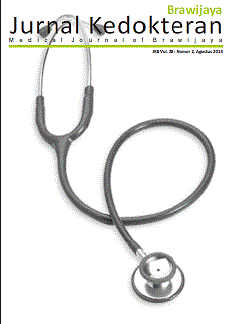Antiplasmodial Test of Tinospora crispa Stem Extract against Plasmodium falciparum 3D7 Strain In Vitro
DOI:
https://doi.org/10.21776/ub.jkb.2014.028.02.6Abstract
This study aimed to prove the existence of anti-plasmodial activity from Tinospora crispa (T. crispa) stem extracts and to determine the IC50 values as well as the best T. crispa stem extract concentration in inhibiting the growth of P. falciparum 3D7 strain in vitro. The degree of parasitemia was observed by counting the number of infected red blood cells in Giemsa stained blood films under a light microscope with a magnification of 1000x. The Plasmodium DNA concentration was measured using flow cytometryc with Propidium Iodide (PI) staining. Analysis of fourier transform infrared (FTIR) spectrophotometer showed that the methanol extracts of T. crispa stem contained tinocrisposide compound. From the quantitative test results of Thin Layer Chromatography (TLC), it was obtained 0,22 % alkaloids that might contain compounds of berberine and palmatine. One way ANOVA statistical analysis showed that the degree of parasitemia and the concentration parasite DNA of treatment group of dose of 2,0mg/ml was significantly lower compared to the control group after 48 hours (p=0,001) and 72 hours (p=0,001) of incubation. The T. crispastem methanol extract has anti-plasmodium activity, with IC50 values between 0,27 mg/ml and 0,29mg/ml, and the effective dose to inhibit the growth of P. falciparum 3D7 strain is 2,0 mg/ml with reducing parasitemia degree by 47,12% and 56,83% after 72 hours of incubation. From this study shown the methanol extract of T. crispastem was able to reduce the parasitemia degree of P. falciparum 3D7 strain in vitro and could to be a potential candidate for anti malarias.
Keywords: Antiplasmodium, methanol extract, T. crispa, Plasmodium falciparum
Downloads
References
Singh B, Kim Sung L, Matusop A, et al. A Large Focus of Naturally Acquired Plasmodium Knowlesi Infections In Human Beings. The Lancet. 2004; 363(9414): 1017–1024.
World Health Organization. World Malaria Report 2011. (Online) 2011. http://www.who.int/malaria/ world_malaria_report_2011/en/. [accessed on Oktober 27, 2013].
Departemen Kesehatan Republik Indonesia. Pedoman Penatalaksanaan Kasus Malaria di Indonesia. Jakarta: Direktorat Jendral Pengendalian Penyakit dan Penyehatan Lingkungan; 2008.
Departemen Kesehatan Republik Indonesia. Pelayanan Kefarmasian untuk Penyakit Malaria. Jakarta: Direktorat Jendral Bina Kefarmasian dan Alat Kesehatan; 2008.
World Health Organization. Antimalarial Drug Combination Therapy. Report of a WHO Technical Consultation. Geneve, Swiss: Roll Back Malaria/World Health Organization; 2001.
Wijayakusuma HMH. Tanaman Berkhasiat Obat di Indonesia. Jilid I. Jakarta: Pustaka Kartini; 1992 .
Adnan AZ, Gusmali DM, and Mukhtar MH. Antimalarial Activity of Tinocrisposide Compound In Vivo. Cermin Dunia Kedokteran. 2001; 131: 27–31.
Rungruang T and Boonmars T. In Vivo Antiparasitic Activity of the Thai Traditional Medicine Plant Tinospora crispa against Plasmodium Yoelii. The Southeast Asian Journal of Tropical Medicine and Public Health. 2009; 40(5): 898-900.
Najib Nik A Rahman N, Futura T, Kojima S, Takane K, and Ali MM. Antimalarial Activity of Extracts of Malaysian Medicinal Plants. Journal of Ethnopharmacology. 1999; 64(3): 249–254.
Silvesterstein RM, Webster FX, and Kiemle DJ. Spectrometric Identification of Organic Compounds. New York: John Wiley & Sons; 1963.
Kresnady B dan Tim Lentera. Khasiat dan Manfaat Brotowali Si Pahit yang Menyembuhkan. Jakarta: Agromedia Pustaka; 2005; hal. 10 – 14.
Sukadana IM, Rita WS, and Koreh FR. Isolasi dan Identifikasi Senyawa Antimakan dari Batang Tumbuhan Brotowali (Tinospora Tuberculata BEUMEE). Jurnal Kimia. 2007; 1(2): 55-61.
Ancelin ML and Vial HJ. Quaternary Ammonium Compounds Efficiently Inhibit Plasmodium falciparum Growth In Vitro by Impairment of Choline Transport. Antimicrobial Agents and Chemotherapy. 1986; 29(5): 814–820.
Roshental PJ. Review. Antimalarial Drug Discovery: Old and New Approaches. The Journal of Experimental Biology. 2003; 206: 3735-3744.
Birdsall TC and Kelly GS. Berberine: Therapeutic Potential of an Alkaloid Found in Several Medicinal Plants. Alternative Medicine Review. 1997; 2(2): 94-103.
Simanjuntak P. Tumbuhan Sebagai Bahan Aktif Antimalaria. Buletin Penelitian Kesehatan. 1995; 23(2): 1–11.
Aini N, Soebaktiningsih, Fitri LE, Kalsum U, and Sumarno. Pengaruh Ekstrak Biji Nimba (Azadirachta Indica) Terhadap Penurunan Derajat Parasit dan Jumlah Hemozoin pada Kultur Plasmodium Falciparum. Jurnal Kedokteran Brawijaya. 2004; 20(3): 115-124.
Chantong B, Kampeera T, and Sirimanapong W. Aktivitas Antioksidan Brotowali. (Online) 2008. http://www.actahort.org/members/showpdf?booknrarnr=786_9 [accessed on Oktober 21, 2013].
Dweck AC and Cavin J. Andawali (Tinospora crispa)-a Review. Personal Care Megazine. 2006; 7; 1-3.
Adnan AZ, Husni M, and Almahdy A. Pemeriksaan Farmakologi Senyawa Furanoditerpen Glikosida Baru dari Brotowali (Tinospora crispa Miers). Warta Tumbuhan Obat Indonesia.1998; 4(2): 9-12.
Ridley RG. Malaria: To Kill a Parasite. Nature. 2003; 424: 887-889.
Nurachman Z dan Putrianti ED. Artemisinin, Pembunuh Parasit Malaria. (Online) 2005. [accessed on September 11, 2011].
Departemen Kesehatan Republik Indonesia. Penghentian Monoterapi Artemisinin Mencegah Penyebarluasan Resistensi. (Online) 2006. http://depkes.go.id/index.php? vw=2&id=951. [accessed on September 11, 2013].
Downloads
Published
Issue
Section
License
Authors who publish with this journal agree to the following terms:- Authors retain copyright and grant the journal right of first publication with the work simultaneously licensed under a Creative Commons Attribution License that allows others to share the work with an acknowledgement of the work's authorship and initial publication in this journal.
- Authors are able to enter into separate, additional contractual arrangements for the non-exclusive distribution of the journal's published version of the work (e.g., post it to an institutional repository or publish it in a book), with an acknowledgement of its initial publication in this journal.
- Authors are permitted and encouraged to post their work online (e.g., in institutional repositories or on their website) prior to and during the submission process, as it can lead to productive exchanges, as well as earlier and greater citation of published work (See The Effect of Open Access).














